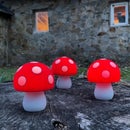Introduction: Matte Finish Motorcycle Tank Painting
I painted this tank a while back and just hadn't gotten around to editing it because the tank still awaits some custom art, a topcoat, and final mounting on my boyfriend's hardtail xs650. But hey, when that happens maybe I'll do a part two! No need to keep this DIY hostage until then, so here it is. This Instructable chronicles the tank's journey from bare metal through two coats of automotive primer and two coats of Hot Rod Flatz matte automotive paint. It was my first time using the Preval sprayers and I thought they worked well for our circumstances (having no compressor-powered spray gun or prior experience with automotive paint).
For this project, I used:
- Peanut gas tank
- Plastic drop cloth
- Automotive epoxy primer and its hardener
- Hot Rod Flatz flat car paint, 1qt kit in Wimbledon White (comes with reducer, strainers, & stir-sticks)
- Funnel
- Preval sprayer
- Respirator
- Gloves
- Eye protection
- Paper/cloth towels
- Rubbing alcohol
- Wet/dry sandpaper
- Hook to hang tank from ceiling
To keep up with what I'm working on, follow me on YouTube, Instagram, Twitter, Pinterest, and subscribe to my newsletter. As an Amazon Associate I earn from qualifying purchases you make using my affiliate links.
Be sure to read and understand all the manufacturer's instructions for the primer, paint, and sprayers. These are dangerous chemicals that can seriously harm you if you don't wear the proper safety gear— a respirator is not optional. If you don't want epoxy and urethane paint in your hair, cover up with long sleeves and a bandana. Cover your work surface and nearby surfaces with plastic to prevent a thin mist of primer and paint from landing on everything in the area. While working outside could be great, you don't want pollen or other debris to collect on your drying tank surface, so keep that in mind when choosing where to work.
Step 1: Prepare Bare Metal Tank
Drill any necessary mounting holes before beginning the painting process. Sand the surface of the tank (IIRC 800 grit) to remove any surface debris and create some texture for the primer to bind to, and wipe clean with a clean towel.
Step 2: Spray First Primer Coat
Next, mix up your primer. Put on your respirator, eye protection, gloves, and arm/hair covering, and stir the epoxy primer thoroughly. Pour the primer through the strainer/funnel into the Preval chamber, followed up by the hardener, in the ratio described on the label's instructions. Since the primer is so thick, I removed the strainer cap at the end of the Preval sprayer tube before attaching the sprayer to the chamber. Optionally click on an easy-spray handle, and test out that the primer sprays out when the button is depressed.
I hung the tank up to make it easier to paint it evenly.
Once your primer is completely ready to go, you can then wipe the tank down with rubbing alcohol. You want to do this as close to painting as possible, since it leaves the surface so clean that it will oxidize quickly. Spray evenly to coat the tank in its first coat of primer, then follow the label's instructions about how long to let it dry.
Step 3: Sand and Second Primer Coat
Lightly sand the first primer coat to even out any dribbles, thick spots, or other imperfections. Use water with the sandpaper if you want to cut down on the dust, then wipe with a clean damp towel to remove any residue before hanging the tank back up, this time from the opposite end than before.
This final coat of epoxy primer should fill any remaining thin spots or details you missed in the first coat, and should be lightly sanded once completely dry.
Step 4: First Paint Coat
Stir up the paint and strain it into a sprayer chamber along with the appropriate amount of reducer according to the label's instructions. Spray it on the tank in the same manner as the primer, making even movements at a consistent distance. Don't worry about getting it perfect with the first coat, since you can do one or two more, depending on your preference. Follow the label's instructions for dry time, and use some more wet-dry sandpaper to clean up mistakes and further even out the surface between coats.
Step 5: Final Paint Coat
I turned the tank upside down again before the second color coat to make sure I was getting paint evenly on all the tank's details. After drying, a few sanding passes with progressively finer grit paper established the super-matte goal surface.
Step 6: Finished (for Now...)
After this tank gets some custom artwork, it will get a final matte (also called low-gloss) topcoat and be mounted to the motorcycle. Thanks for reading, and let me know in the comments if you have suggestions for how to improve this newb's technique, and show me what you paint!
Thanks for reading! You might be interested in some of my other motorcycle projects:





